

What does it mean to be GREAT at maths. (402) Beautiful Visual Explanation of Completing the Square. Resources15.html. Using the LOMAS Test to Measure and Monitor Numeracy, referenced to NZC Level.
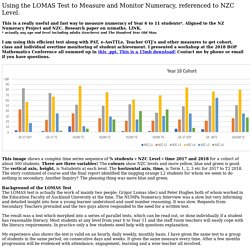
This is a really useful and fast way to measure numeracy of Year 6 to 11 students*. Aligned to the NZ Numeracy Project and NZC. Research paper on nzmaths. LINK. Mr. P's Math Page. Mathalicious. Connect Three. The game Connect Three is played with two spinners, one with the numbers and the other with the numbers .
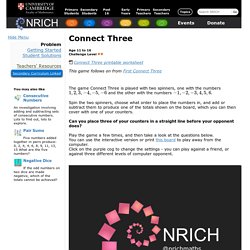
Spin the two spinners, choose what order to place the numbers in, and add or subtract them to produce one of the totals shown on the board, which you can then cover with one of your counters. Can you place three of your counters in a straight line before your opponent does? Play the game a few times, and then take a look at the questions below. You can use the interactive version or print this board to play away from the computer.
Click on the purple cog to change the settings - you can play against a friend, or against three different levels of computer opponent. Some numbers can only be made in one way, but some can be made in many different ways. Risps: Rich Starting Points for A Level Core Mathematics. This collection of forty starting activities for A level mathematics provided by RISPs is intended to enrich the lives of mathematics students in lots of A Level classrooms.
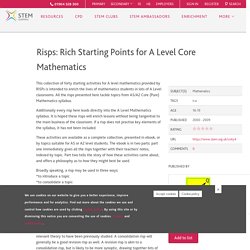
All the risps presented here tackle topics from AS/A2 Core (Pure) Mathematics syllabus. Additionally every risp here leads directly into the A Level Mathematics syllabus. It is hoped these risps will enrich lessons without being tangential to the main business of the classroom. If a risp does not practise key elements of the syllabus, it has not been included. These activities are available as a complete collection, presented in ebook, or by topics suitable for AS or A2 level students. BestMaths. Student Guide. Science project. What forces act on a bridge?
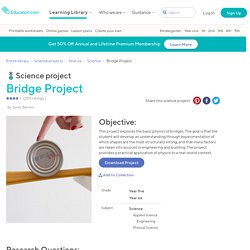
What are some of the different types of bridges? BUILDING BIG: The Bridge Challenge. Welcome to Craggy Rock!
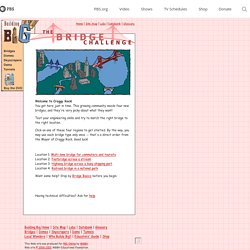
You got here just in time. This growing community needs four new bridges, and they're very picky about what they want! Test your engineering skills and try to match the right bridge to the right location. Click on one of these four regions to get started. By the way, you may use each bridge type only once -- that's a direct order from the Mayor of Craggy Rock. Engineering a Bridge. This lesson will involve your students in geometry and measurement as they work as civil engineers to design and build their own bridge.
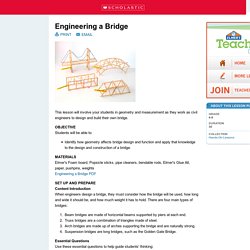
OBJECTIVE Students will be able to: Identify how geometry affects bridge design and function and apply that knowledge to the design and construction of a bridge. MATERIALS Elmer's Foam board, Popsicle sticks, pipe cleaners, bendable rods, Elmer's Glue All, paper, pushpins, weightsEngineering a Bridge PDF SET UP AND PREPAREContent Introduction When engineers design a bridge, they must consider how the bridge will be used, how long and wide it should be, and how much weight it has to hold. There are four main types of bridges:
Teachers TryScience. Bridge design has changed and improved over time.
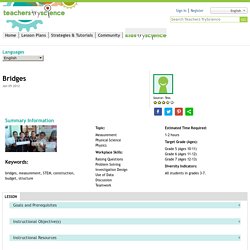
The “clapper bridge” is one of the earliest types of bridges. This is a low bridge that is made of flat stones or logs. The “clapper bridge” is a natural bridge. Ancient Romans refined bridge building. They used the arch design and incorporated natural cement. Sample work STEM Stage 2: Activity 12 – Build a bridge. Description of activity.
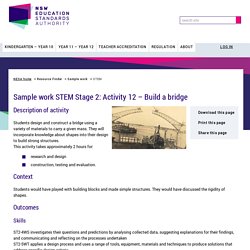
Operation Build a Bridge and Get Over It - Activity. Summary Students act as structural engineers and learn about forces and load distributions as they follow the steps of the engineering design process to design and build small-scale bridges using wooden tongue depressors and glue.
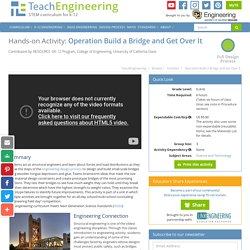
Teams brainstorm ideas that meet the size and material design constraints and create prototype bridges of the most promising solutions. They test their bridges to see how much weight they can hold until they break and then determine which have the highest strength-to-weight ratios. They examine the prototype failures to identify future improvements. This activity is part of a unit in which multiple activities are brought together for an all-day school/multi-school concluding “engineering field day” competition. This engineering curriculum meets Next Generation Science Standards (NGSS). Boosting Math.
Algebra. This page lists recommended resources for teaching algebraic topics at Key Stage 3/4.
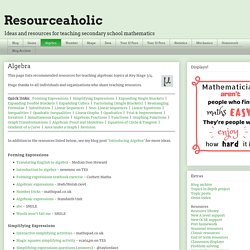
Huge thanks to all individuals and organisations who share teaching resources. Mathematics Anxiety: What Have We Learned in 60 Years? Alternative Math (2017 Short Film) Great Maths Teaching Ideas – Sharing great ideas and resources with maths teachers. Vi Hart.
Developing Mathematical Inquiry Communities. Making Maths: Clinometer. A clinometer is a tool that is used to measure the angle of elevation, or angle from the ground, in a right - angled triangle. You can use a clinometer to measure the height of tall things that you can't possibly reach to the top of, flag poles, buildings, trees. Follow the directions below to create your own clinometer. You will need: Mathematics is the sense you never knew you had. Interactive Unit Circle. MathsNZ Students. MathsNZ Students - 1.7 - Part 1: Pythagoras. Visual Patterns - 1-20. Graphs. #TMC14 GWWG: Talking Points Activity – cultivating exploratory talk through a growth mindset activity. This activity is the one I am most excited about bringing to #TMC14 and to the Group Work Working Group.
My intention is to blog more about how this goes during the morning sessions. I also hope that participants will blog more about this too and contribute resources to the wiki. Exploratory talk is the greatest single predictor of whether group work is effective or not, yet most symmetrical classroom talk (peer talk) is either cumulative (positive but uncritical) or disputational (merely trading uncritical disagreements back and forth).
This activity is based on Lyn Dawes’ Talking Points activity but has been adapted for use within a restorative practices framework. It’s a great way to practice circle skills (i.e., respecting the talking piece) and get students to practice NO COMMENT (i.e., trying to score social points rather than focusing on the task at hand). Get students into groups of three. Talking Points is a timed activity. TALKING POINTS ACTIVITY 10 minutes. ASKING STUDENTS TO CHOOSE A PATH AND JUSTIFY IT. Graphing Stories - 15 seconds at a time. 101questions.
Dan Meyer on Real-World Math. Quadratic Functions and Parabolas in the Real World. Exponential Growth: a Commonsense Explanation. How Folding Paper Can Get You to the Moon. Exponential Growth. SolveMe Puzzles. Online Student Course - YouCubed. Assessent paper final 4.22.18. Mathematical Mindset Teaching Guide, Teaching Video and Additional Resources. We have designed a Mathematical Mindset Guide to help teachers create or strengthen a growth mindset culture. This guide contains five Mathematical Mindset Practices along with links to teaching videos. The videos all show Jo and Cathy teaching middle school students. There are different stages described in each practice to help capture the journey of a mathematical mindset classroom and the evidence teachers may collect along the way for their own reflection or for discussion with colleagues.
The guide has been designed for teachers to use in the process of self-reflection, or for coaches or administrators to use to encourage a mindset teaching culture. In the interactive version of the guide on this web page, you can click on the arrow buttons in the Expanding descriptors to see a short extract of Jo/Cathy teaching in the ways described. Our goal for the guide is to support a mathematical mindset journey of learning and growth. You can download the guide here. MathHooks. Rational Mathematics Education: Khan, you bloodsucker! KHAAAAAN! (More musings on the Khan Academy) Why do many well-meaning (and some not-so-well-meaning) people think that the Khan Academy is THE panacea for various woes, perceived and real, in US mathematics education?
Perhaps no one has expressed love for Sal Khan and his on-line videos than a recent anonymous commentator on my last blog piece (way back in November 2011): "Wont' Get Khanned Again: How Can Education Help Democracy Trump Capitalism? " This anonymous poster wrote: I am a student studying in grade 11 and all I am concerned with is what you have said about Sal Khan. I have a great amount of respect for him since he is the reason my maths mark went from a 55 to a 78 and my chemistry mark went from a 66 to an 83. All this happened over the coarse of 2 months!